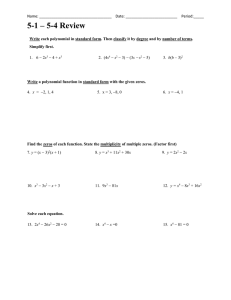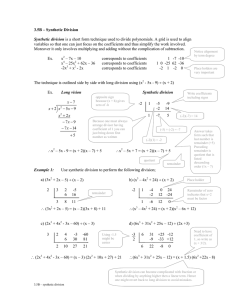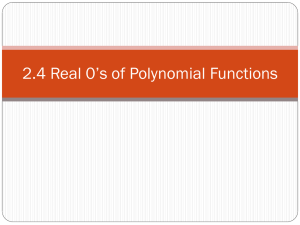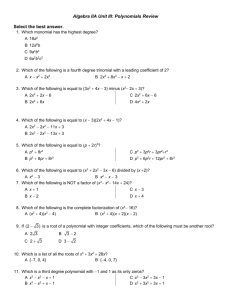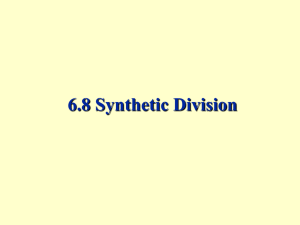Algebra 2
advertisement
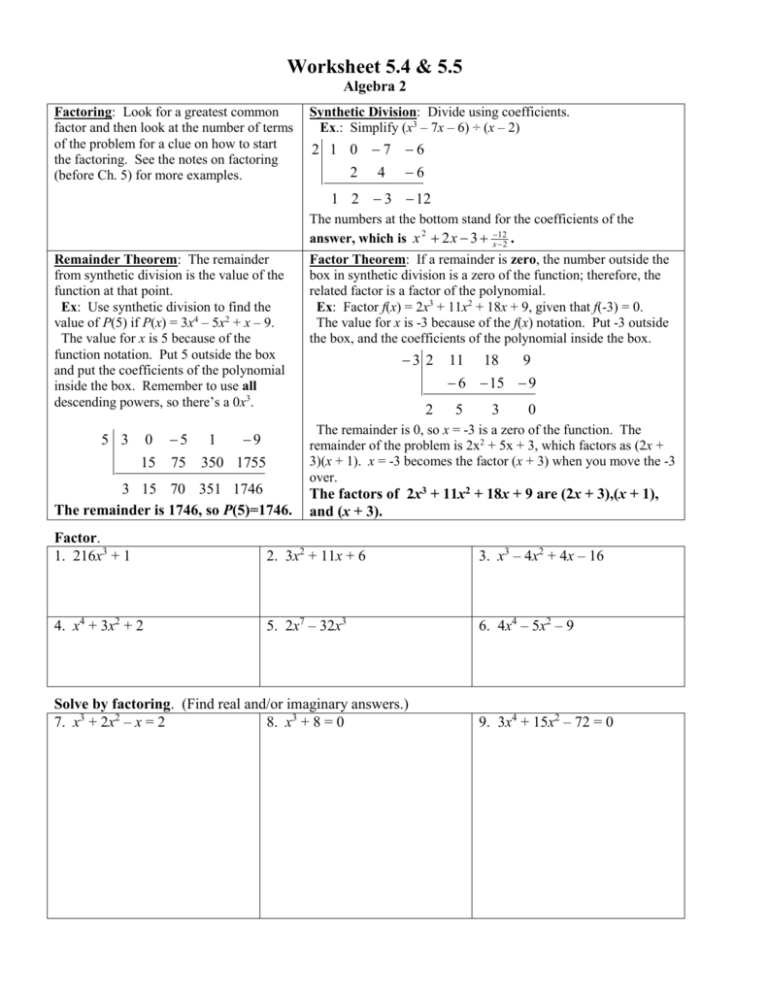
Worksheet 5.4 & 5.5 Algebra 2 Factoring: Look for a greatest common factor and then look at the number of terms of the problem for a clue on how to start the factoring. See the notes on factoring (before Ch. 5) for more examples. Synthetic Division: Divide using coefficients. Ex.: Simplify (x3 – 7x – 6) ÷ (x – 2) 2 1 0 7 6 2 4 6 1 2 3 12 Remainder Theorem: The remainder from synthetic division is the value of the function at that point. Ex: Use synthetic division to find the value of P(5) if P(x) = 3x4 – 5x2 + x – 9. The value for x is 5 because of the function notation. Put 5 outside the box and put the coefficients of the polynomial inside the box. Remember to use all descending powers, so there’s a 0x3. 0 5 15 75 350 1755 5 3 1 9 3 15 70 351 1746 The remainder is 1746, so P(5)=1746. The numbers at the bottom stand for the coefficients of the answer, which is x 2 2 x 3 x122 . Factor Theorem: If a remainder is zero, the number outside the box in synthetic division is a zero of the function; therefore, the related factor is a factor of the polynomial. Ex: Factor f(x) = 2x3 + 11x2 + 18x + 9, given that f(-3) = 0. The value for x is -3 because of the f(x) notation. Put -3 outside the box, and the coefficients of the polynomial inside the box. 3 2 2 11 18 9 6 15 9 5 3 0 The remainder is 0, so x = -3 is a zero of the function. The remainder of the problem is 2x2 + 5x + 3, which factors as (2x + 3)(x + 1). x = -3 becomes the factor (x + 3) when you move the -3 over. The factors of 2x3 + 11x2 + 18x + 9 are (2x + 3),(x + 1), and (x + 3). Factor. 1. 216x3 + 1 2. 3x2 + 11x + 6 3. x3 – 4x2 + 4x – 16 4. x4 + 3x2 + 2 5. 2x7 – 32x3 6. 4x4 – 5x2 – 9 Solve by factoring. (Find real and/or imaginary answers.) 7. x3 + 2x2 – x = 2 8. x3 + 8 = 0 9. 3x4 + 15x2 – 72 = 0 Divide using synthetic division. 10. ( x3 – 14x + 8) ÷ (x + 4) 11. (x4 – 6x3 – 40x + 33) ÷ (x – 7) 12. (3x2 – 10x) ÷ (x – 6) Factor the polynomial. 13. f(x) = x3 – 3x2 – 16x – 12, and f(6) = 0. 14. f(x) = x3 – 11x2 + 14x + 80, and f(8) = 0. 15. f(x) = 2x3 + 7x2 – 33x – 18, and f(-6) = 0. 16. f(x) = x3 – x2 – 21x + 45, and f(-5) = 0. Find the zeros of the function given that one of the zeros is ___. 17. f(x) = 2x3 + 3x2 – 39x – 20, and 4 is a zero. 18. f(x) = x3 + 11x2 – 150x – 1512, & -14 is a zero. 19. f(x) = x3 + x2 +2x + 24, and -3 is a zero. 20. f(x) = 4x3 + 9x2 – 52x + 15, and -5 is a zero.
